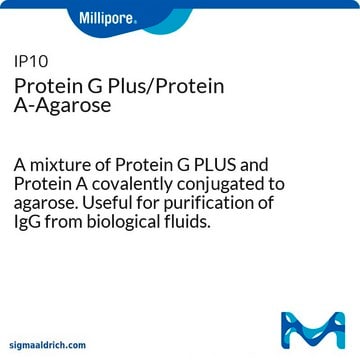P6649
Protein A–Sepharose™ 6 MB
aqueous ethanol suspension
Synonym(e):
Protein-A-Agarose-Makrobeads
About This Item
Empfohlene Produkte
Form
aqueous ethanol suspension
Kennzeichnungsgrad
~1 mg per mL
Matrixaktivierung
cyanogen bromide
Matrixanbindung
amino
Matrix-Spacer
1 atom
Kapazität
~6 mg/mL binding capacity (human IgG)
Lagertemp.
2-8°C
Suchen Sie nach ähnlichen Produkten? Aufrufen Leitfaden zum Produktvergleich
Allgemeine Beschreibung
Anwendung
Physikalische Form
Rechtliche Hinweise
Signalwort
Warning
H-Sätze
Gefahreneinstufungen
Flam. Liq. 3
Lagerklassenschlüssel
3 - Flammable liquids
WGK
WGK 3
Flammpunkt (°F)
100.4 °F
Flammpunkt (°C)
38 °C
Analysenzertifikate (COA)
Suchen Sie nach Analysenzertifikate (COA), indem Sie die Lot-/Chargennummer des Produkts eingeben. Lot- und Chargennummern sind auf dem Produktetikett hinter den Wörtern ‘Lot’ oder ‘Batch’ (Lot oder Charge) zu finden.
Besitzen Sie dieses Produkt bereits?
In der Dokumentenbibliothek finden Sie die Dokumentation zu den Produkten, die Sie kürzlich erworben haben.
Kunden haben sich ebenfalls angesehen
Unser Team von Wissenschaftlern verfügt über Erfahrung in allen Forschungsbereichen einschließlich Life Science, Materialwissenschaften, chemischer Synthese, Chromatographie, Analytik und vielen mehr..
Setzen Sie sich mit dem technischen Dienst in Verbindung.












